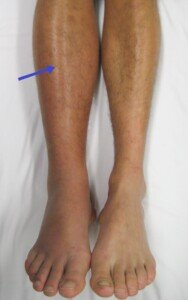Which is better for DVT treatment: a blood thinner drug or catheter-based removal?
A Temple University School of Medicine study involving 90,000 patients has an interesting conclusion.
The mortality rate between the two DVT treatments is the same. However, the catheter procedure brings more risk of bleeding.
This, however, is not related to the efficacy of the catheter treatment as far as removing the blood clot.
What is the catheter-based treatment for deep vein thrombosis?
This minimally invasive procedure involves catheter insertion through veins to deliver a clot-busting drug right at the site of the DVT.
This procedure costs more than anticoagulant therapy (blood thinner) and requires more days in the hospital.
Within 30 days of diagnosis, about six percent of patients with a DVT die.
In these cases, the blood clot breaks loose and travels to the lung (where it’s now known as a pulmonary embolism), cutting off oxygen supply.
Despite 90,000 cases being involved in this research, it was considered too small for any rock-solid conclusions to be drawn regarding the safety of the catheter-based therapy vs. anticoagulants alone for the DVT treatment.
Blood Thinning Drugs
The study might have you wondering about the use of blood thinning drugs for treating a DVT that’s already present.
“Blood thinners (anticoagulants) prevent formation of a new clot; they do not dissolve the clot,” points out Dr. Paramjit “Romi” Chopra, MD, founder of the Midwest Institute for Minimally Invasive Therapies (MIMIT), an interventional radiology and endovascular therapy practice.
“Catheter directed thrombolysis (removal of clot) is required in cases where the clot burden is extensive and the body’s natural mechanisms cannot dissolve it.
“We want to avoid chronic DVT and the post-phlebitic syndrome.”
Catheter-directed thrombolysis (thrombolysis = breaking up a blood clot) leads to a big reduction in the chances of developing this post-thrombotic or phebitic syndrome, an often debilitating condition of the legs.
PTS, a painful condition, is more likely to occur in patients for whom the clot occurs above knee level, particularly in the hip and groin area.
The American College of Chest Surgeons favors drugs alone, while the American Heart Association favors the catheter procedure — at least for people at low risk for bleeding.













